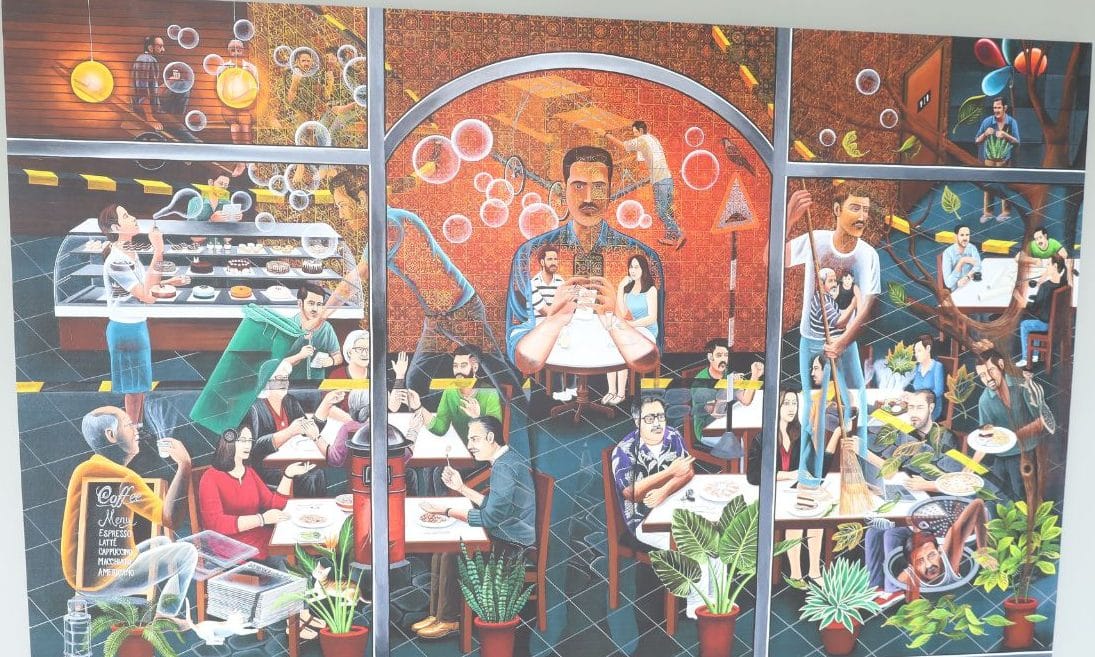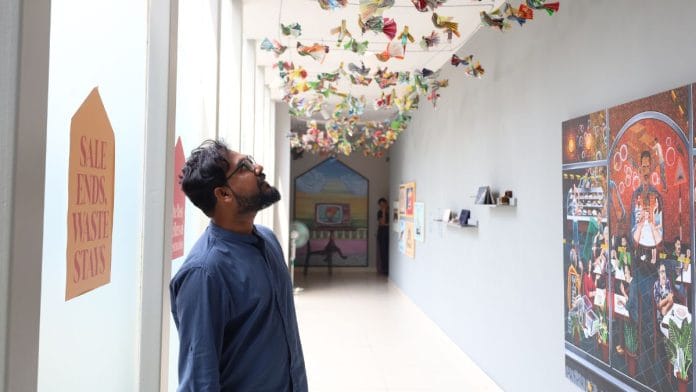New Delhi: A mall isn’t a museum. Delhi’s Nexus Select Citywalk mall in Saket has a design aesthetic, but it isn’t an art gallery. But this is where the Kiran Nadar Museum of Art curator Avik Debdas wanted to discomfort the consumers lulled by the warm light of store windows and the lure of fast fashion.
The “corridor of commerce turned into a corridor of conscience,” said Debdas, a former mechanical engineer who earlier worked in a chemical plant producing purified terephthalic acid—the very substance used to make PET bottles.
Before the mall’s glow registers or the weight of shopping bags settles in the hand, something else interrupts the visitors’ stride. Etched into the stairs are warnings: “Incognito Mode Won’t Save You”, “Your Clicks, Their Currency”, “Fast Fashion, Faster Extinction.” Some visitors scroll past. A few pause—long enough to notice a trail of turtles sculpted from discarded plastic wrappers. The stairs keep screaming. But no one reads the footnotes anymore.
This is part of an exhibit, Slow is the New Urgent, curated by Debdas. It brings together collage artists, graphic designers, and eco-assemblage practitioners, each with a distinct focus and compelling backstory. Some of the featured artists include Manveer Singh (also known as Plasticvalla), Anshu Jakhar, CK Rajan, Hifzul Kabeer, KM Madhusudhanan, and Tahsin Akhtar.
“Curating this exhibition is not merely a creative pursuit; it’s an ethical response, where we might reconsider what we are consuming and what is consuming us.” explained Debdas. “Here, contemplation outvalues consumption and to pause is to defy”.
A liminal space
While earlier eco-exhibits may have stopped at plastic turtles, this one refuses to stay there. It stretches, expands, and implicates. Pollution, it suggests, is no longer just in oceans or air. It’s in the objects we carry, the habits we scroll through, and even the spaces we inhabit. The art pieces don’t just hang; they watch back.
Schön Mendes’ Restaurant draws viewers in, quite literally. At first glance, it’s a familiar scene of a restaurant. But when seen through the zoom of the central character’s phone, the painting shows urban planners and manhole cleaners sharing the same frame. Reality and reflection blur across a glass facade, drawing a quiet but unmistakable line through class and visibility.

The mobile camera in his hand becomes a ‘mirror of contradictions’, capturing the layered realities around him, just as it reflects the visitors who pass by. Shoppers pass through this liminal space, clutching plastic coffee cups and heavy bags of fast fashion. Some stop to take a selfie.
These juxtaposed realities are particularly visible in Silpa Sheeja’s animation film and digital drawings titled Techman – Day Boundary. A hybrid human emerges trapped in a digital loop—scrolling, clicking, watching, and being watched. The screen isn’t just in front of him, it’s a part of him. Just like the young boys who, when came along this piece, had an immediate instinct to pull out their phones and record it. They became part of it.
Tahsin Akhtar’s In Constant Flicker, a projection on sculpted objects, shows a new kind of surveillance—a watchtower made not of stone, but pixels. Drones hovering like butterflies, which now serve a different master: the algorithm.

Additionally, on display are real cookies interpretive of the cookies we consent to when accessing a website. Technology is no longer just a tool but an omnipresent force that watches, guides, and reshapes our behaviour. In a world where attention is a currency and every action is tracked, the tyranny of the gaze has been replaced by the glow of the screen—every tap, swipe, and pause is recorded, analysed, and re-packaged.
“It’s almost dystopian. What’s inside the malls, and what’s in this walkway, they feel like two different realities battling for attention,” said a woman to herself, staring at the artworks.
Also read: Babri Masjid to Gujarat riots—exhibition traces Gulammohammed Sheikh’s artistic journey
‘Slowness is not inertia’
Refusing to fade into the background, Pallavi Singh’s Hypno Bazaar reflects on the marketplace of identity, raising questions on how metrosexuality and modernity are sold with equal urgency and equal environmental cost. Her work examines how market forces dictate aesthetic ideals, luring individuals into an endless cycle of self-reinvention, and uses strong visual language to convey the ecological and psychological cost. The piece unpacks metrosexuality as a construct shaped by market forces, where self-expression often folds into consumerism and conformity.

Not just our waking lives, but even sleep, Sonam Chaturvedi’s multiform lexicon titled pixel:dust suggests, is no longer our own. Through books, cards, and a raat ki rani box, her work examines how capitalism colonises the night and turns what was once a pause into just another stretch of time to produce, to scroll, to be seen.
“If there’s one thing I hope people carry with them,” Avik said, “it’s this: slowness is not inertia, it’s resistance.” In a world of last-minute deliveries, algorithmic instincts, and manufactured desires, to pause is to reclaim agency.
The exhibition will go on until 30 June.
Aleeza Ahmed graduated from Batch 2, ThePrint School of Journalism.






